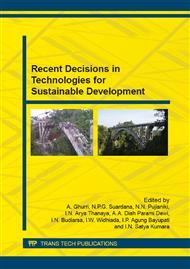[1]
A.D. Jayal, F. Badurdeen, O.W. Dillon Jr, I.S. Jawahir. Sustainable manufacturing: modeling and optimization challenges at the product, process and system levels. CIRP Journal of Manufacturing Science and Technology 2010; 2(3): 144–52.
DOI: 10.1016/j.cirpj.2010.03.006
Google Scholar
[2]
A.N. Nambiar. Challenges in sustainable manufacturing. Proceedings of the International Conference on Industrial Engineering and Operations Management (2010).
Google Scholar
[3]
C.A. Rusinko. Green manufacturing: an evaluation of environmentally sustainable manufacturing practices and their impact on competitive outcomes. IEEE Transactions on Engineering Management 2007; 54(3): 445-54.
DOI: 10.1109/tem.2007.900806
Google Scholar
[4]
W.L. Ijomah, C.A. McMahon, G.P. Hammond, S.T. Newman. Development of design for remanufacturing guidelines to support sustainable manufacturing. Robotics and Computer-Integrated Manufacturing 2007; 23: 712–9.
DOI: 10.1016/j.rcim.2007.02.017
Google Scholar
[5]
T. Elhasia, B. Noche, L. Zhao. Simulation of a sustainable cement supply chain; proposal model review. World Academy of Science, Engineering and Technology 2013; 75: 470-8.
Google Scholar
[6]
M.B. Ali, R. Saidur, M.S. Hossain. A review on emission analysis in cement industries. Renewable and Sustainable Energy Reviews 2011; 15: 2252-61.
DOI: 10.1016/j.rser.2011.02.014
Google Scholar
[7]
N. Pardo, J.A. Moya, A. Mercier. Prospective on the energy efficiency and CO2 emissions in the EU cement industry. Energy 2011; 36: 3244–54.
DOI: 10.1016/j.energy.2011.03.016
Google Scholar
[8]
A.A. Uson, A. M. Lopez-Sabiron, G. Ferreira, E. L. Sastresa. Uses of alternative fuels and raw materials in the cement industry as sustainable waste management options. Renewable and Sustainable Energy Reviews 2013; 23: 242–60.
DOI: 10.1016/j.rser.2013.02.024
Google Scholar
[9]
M.V. Seebach, L. Schneider. Update on finish grinding with improved energy efficiency. World Chem 1986; 17(8): 336–46.
Google Scholar
[10]
E. Worrel, N. Martin, L. Price. Potentials for energy efficiency improvement in the US cement industry. Energy 2000; 25: 1189–214.
DOI: 10.1016/s0360-5442(00)00042-6
Google Scholar
[11]
E. Worrell, L. Price, N. Martin, C. Hendriks, M. L. Ozawa. Carbon dioxide emissions from the global cement industry. Annual Review of Energy and theEnvironment 2001; 26: 303–329.
Google Scholar
[12]
WBCSD, IEA. Cement Technology Roadmap 2009: Carbon Emissions Reductions up to 2050. World Business Council for Sustainable Developmentand International Energy Agency. <http: /wbcsdcement. org/pdf/technology/WBCSD-IEA_Cement%20Roadmap. pdf>.
DOI: 10.1787/9789264088061-en
Google Scholar
[13]
M. Katsioti, P.E. Tsakiridis,P. Giannatos, Z. Tsibouki, J. Marinos. Characterization of various cement grinding aids and their impact on grindability and cement performance. Construction and Building Materials 2009; 23: 1954-(1959).
DOI: 10.1016/j.conbuildmat.2008.09.003
Google Scholar
[14]
I. Teoreanu, G. Guslicov. Mechanisms and effects of additives from the dihydroxy-compound class on Portland cement grinding. CemConcr Res1999; 29(9): 9–15.
DOI: 10.1016/s0008-8846(98)00180-x
Google Scholar
[15]
A.A. Jeknavorian, E.F. Barry, F. Serafin. Determination of grinding aids in Portland cement by pyrolysis gas chromatography–mass spectrometry. CemConcr Res1998; 28(9): 1335–45.
DOI: 10.1016/s0008-8846(98)00109-4
Google Scholar
[16]
J.J. Assaad, S. Asseily, J. Harb. Effect of specific energy consumption on cement fineness incorporating amine and glycol-based grinding aids, Mater. Struct. 2009; 42(8): 1077–1087.
DOI: 10.1617/s11527-008-9444-0
Google Scholar


